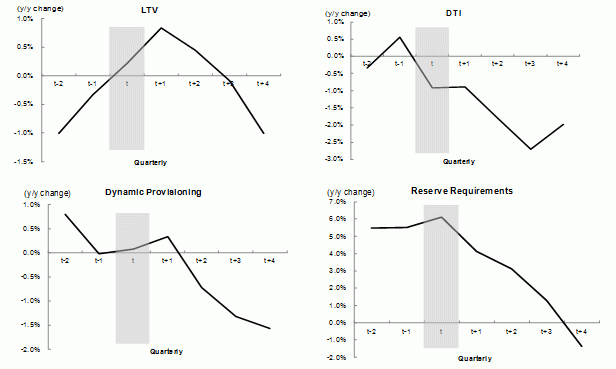Macroprudential policy is quickly gaining traction in international circles as a useful tool to address system-wide risks in the financial sector (see for example Borio 2011, Galati and Moessner 2011, Viñals 2010, 2011). Yet the analytical and operational underpinnings of a macroprudential framework are not fully understood and the effectiveness of the instruments is uncertain. In a recent IMF working paper (Lim et al 2011), we assess the effectiveness of macroprudential instruments using three different approaches.
The first approach is a case study involving an examination of the use of instruments in a small but diverse group of countries; these are China, Colombia, Korea, New Zealand, Spain, the US, and some Eastern European countries. Their experience suggests that, to various degrees, the instruments may be considered effective in addressing systemic risk in their respective country-specific circumstances, regardless of the size of their financial sector or exchange rate regime.
- In China, the authorities managed to lower credit growth and housing price inflation by taking a series of steps in 2010 that also included fiscal and monetary measures.
- In Colombia, the authorities took measures in 1999 to limit banks’ exposure to default risk. The measures seem to have been effective. Non-performing loans declined and remained low while credit to the private sector recovered after an initial reduction.
- In Eastern Europe, the authorities adopted several measures to curb bank lending in foreign currency. The instruments appear to have been effective in slowing credit growth and building capital and liquidity buffers, although they were circumvented partly as lending activity migrated to non-banks (leasing companies) and to direct cross-border lending by parent banks.
- In Spain, the authorities introduced dynamic provisioning as a macroprudential tool in 2000. The instrument appears to have been effective in helping to cover rising credit losses during the global financial crisis, but the coverage was less than full because of the severity of the actual losses and the cap imposed in 2005 on the size of provisions.
- In Korea, theauthorities adopted measures after the financial crisis to deal with the build-up of vulnerabilities associated with capital flows. They appear effective in curbing banks’ short-term external borrowing, which remained some 30% below its pre-crisis levels as of 2010.
- In New Zealand, the authorities introduced two liquidity mismatch ratios and a core funding ratio in 2010 to limit banks’ liquidity risk. The ratios had an effect even before they were formally implemented – banks began to lengthen their wholesale funding structure after the ratios’ announcement.
- In the US, the authorities adopted a minimum leverage ratio for banks in 1991. The requirement was not adjusted over time in response to changing circumstances, but a key weakness was the fact that it did not apply to investment banks after 2004. As result of the divergence in regulatory requirements, leverage rose noticeably at investment banks but remained lower at commercial banks.
The second approach involves an examination of the performance of the target (risk) variables, such as excessive credit growth, before and after an instrument is introduced to see if they have had the intended effect, as shown in Figure 1 for the case of credit growth. We find that, throughout the economic cycle, macroprudential instruments seem to have been effective in reducing the correlation between credit and GDP growth. In countries that have introduced caps on the loan-to-value ratio, debt-to-income ratio and reserve requirements, the correlation is positive but much smaller than in countries without them, as shown by the flattening of the curve in Figure 2. In countries that have introduced ceilings on credit growth or dynamic provisioning, the correlation between credit growth and GDP growth becomes negative as shown by an inverted curve. The change in the correlations is also statistically significant, except in the case of caps on foreign currency lending and restrictions on profit distribution.
Figure 1. Change in credit growth after the introduction of instruments
Notes: 1/ Average of sample countries’ y/y growth in credit (detrended). 2/ t denotes the time of the introduction of instruments. 3/ For details, see charts in Appendix III. Source: International Financial Statistics.
Figure 2. Credit growth and GDP growth
The third approach uses a more sophisticated technique to disentangle the effects of other macroeconomic policies from macroprudential policies. Using panel regression analysis, the effectiveness of ten instruments on four types of systemic risks was examined.1 These risks are associated with excessive: (i) credit growth; (ii) systemic illiquidity; (iii) leverage; and (iv) large and volatile capital flows.2 In particular, the regression analysis examines if the instruments limit the procyclicality of each of these factors, that is, their tendency to amplify the business cycle. In the paper, procyclicality is defined as the respective correlation of credit or leverage growth with GDP growth. In addition, two other instruments3 were assessed for their effectiveness in reducing common exposures across markets and institutions, using proxies for risks related to the dependence on wholesale funding and foreign currency borrowing, although the scope is limited by data availability.
The results suggest that several of the commonly used macroprudential instruments reduce procyclicality in the financial system, and to a lesser extent risks from common exposures or interconnectedness. The cross-country regression analysis suggests that caps on the loan-to-value ratio, caps on the debt-to-income ratio, ceilings on credit or credit growth, reserve requirements, countercyclical capital requirements, and time-varying/dynamic provisioning may help dampen pro-cyclicality of credit or leverage. The results also suggest that common exposures to foreign currency risk and wholesale funding can be effectively reduced by limits on net open positions in foreign currency and limits on maturity mismatch. The effectiveness of the instruments does not appear to depend on the exchange rate regime nor the size of the financial sector, but the analysis does suggest that the type of shocks do matter. Different types of risks call for the use of different instruments.
While the panel regression yields promising results, more work is needed to confirm our findings. The use of macroprudential instruments is still relatively new, especially for advanced economies. The short experience with macroprudential policy limits the number of observations available for a more definitive evaluation of its effectiveness. Further research with longer time series and better quality data is therefore necessary to corroborate the initial assessment and to evaluate an instrument’s effectiveness in country-specific contexts. Since regulatory and cross-border arbitrage can easily circumscribe the effectiveness of macroprudential policy, these factors should be taken into account in future analyses.
Authors’ note: The views expressed in this column are those of the authors and do not necessarily reflect those of the International Monetary Fund.
References
Borio, C, (2011), “Implementing a Macroprudential Framework: Blending Boldness and Realism”, Capitalism and Society 6(1): Article 1.
Borio, C and I Shim (2007), “What Can (Macro-)Prudential Policy Do to Support Monetary Policy?”, BIS Working Papers 242.
Committee on the Global Financial System (2010), “Macroprudential Instruments and Frameworks: A Stocktaking of Issues and Experiences”,CGFS PapersNo. 38.
Galati, G and R Moessner (2011), “Macroprudential Policy – A Literature Review”, BIS Working Paper 337.
Lim, C, F Columba, A Costa, P Kongsamut, A Otani, M Saiyid, T Wezel, and X Wu (2011), “Macroprudential Policy: What Instruments and How to Use Them? Lessons from Country Experiences”, IMF Working Paper 11/238.
Viñals, J (2010), “Towards a Safer Global Financial System”, presented at London School of Economics.
Viñals, J (2011), “The Do’s and Don’ts of Macroprudential Policy,” presented at European Commission and ECB Conference on Financial Integration and Stability in Brussels.
1 The maximum loan-to-value ratio, the maximum debt-service-to-income ratio, caps on foreign currency lending, ceilings on credit or credit growth, limits on net open currency positions/currency mismatch, limits on maturity mismatch, reserve requirements, counter-cyclical capital requirements, dynamic provisioning, and restrictions on profit distribution.
2 Credit is defined as the change in the inflation-adjusted claims on the private sector by banking and other financial institutions; liquidity risk is the ratio of liquid assets to short-term liabilities; leverage is assets as a fraction of equity, also for banking and other financial institutions; and capital flows are measured in growth rates and volatility of the “other” category in the balance of payments statistics, which mainly captures bank flows.
3 Limits on net open positions in foreign currency and limits on maturity mismatch.







